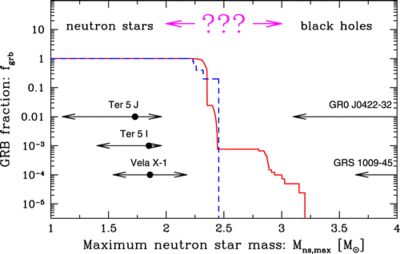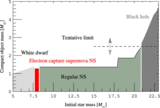Image Details

Caption: Fig. 4.
Gamma‐ray burst production efficiency as a function of the maximum neutron star mass in the framework of the double neutron star model for GRBs involving the formation of a black hole. The mass of the merger product is plotted here as the blue (observations) and red (theory) lines. There is a sharp drop in the number of NS‐NS systems that can form a merger with mass over ﹩2.5\,M_{\odot }﹩. For example, only 1 in 103 NS‐NS mergers can form a remnant with a mass of ﹩2.5\,M_{\odot }﹩ or higher. Therefore, if short GRBs are connected to NS‐NS mergers, the maximum neutron star mass is required to be ﹩M_{\mathrm{ns}\,,\mathrm{max}\,}< 2.5\,M_{\odot }﹩. For comparison we show observed masses of the lowest‐mass black holes (GRO J0422−32, GRS 1009−45; Casares 2006) and highest‐mass neutron stars (Vela X‐1, Terzan 5I, and Terzan 5J; Barziv et al. 2001; Ransom et al. 2005). These observations, along with our findings, constrain the maximum mass of a neutron star to lie in the narrow range of ﹩2{\mbox{--}} 2.5\,M_{\odot }﹩.
Copyright and Terms & Conditions
© 2008. The American Astronomical Society. All rights reserved. Printed in U.S.A.






